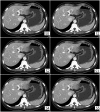Attenuation-based automatic kilovoltage selection and sinogram-affirmed iterative reconstruction: effects on radiation exposure and image quality of portal-phase liver CT
- PMID: 25598675
- PMCID: PMC4296279
- DOI: 10.3348/kjr.2015.16.1.69
Attenuation-based automatic kilovoltage selection and sinogram-affirmed iterative reconstruction: effects on radiation exposure and image quality of portal-phase liver CT
Abstract
Objective: To compare the radiation dose and image quality between standard-dose CT and a low-dose CT obtained with the combined use of an attenuation-based automatic kilovoltage (kV) selection tool (CARE kV) and sinogram-affirmed iterative reconstruction (SAFIRE) for contrast-enhanced CT examination of the liver.
Materials and methods: We retrospectively reviewed 67 patients with chronic liver disease in whom both, standard-dose CT with 64-slice multidetector-row CT (MDCT) (protocol A), and low-dose CT with 128-slice MDCT using CARE kV and SAFIRE (protocol B) were performed. Images from protocol B during the portal phase were reconstructed using either filtered back projection or SAFIRE with 5 different iterative reconstruction (IR) strengths. We performed qualitative and quantitative analyses to select the appropriate IR strength. Reconstructed images were then qualitatively and quantitatively compared with protocol A images.
Results: Qualitative and quantitative analysis of protocol B demonstrated that SAFIRE level 2 (S2) was most appropriate in our study. Qualitative and quantitative analysis comparing S2 images from protocol B with images from protocol A, showed overall good diagnostic confidence of S2 images despite a significant radiation dose reduction (47% dose reduction, p < 0.001).
Conclusion: Combined use of CARE kV and SAFIRE allowed significant reduction in radiation exposure while maintaining image quality in contrast-enhanced liver CT.
Keywords: Computed tomography; Image quality; Iterative reconstruction; Radiation dose reduction; Tube potential.
Figures



References
-
- Lee KH, Lee JM, Moon SK, Baek JH, Park JH, Flohr TG, et al. Attenuation-based automatic tube voltage selection and tube current modulation for dose reduction at contrast-enhanced liver CT. Radiology. 2012;265:437–447. - PubMed
-
- Brenner DJ, Hall EJ. Computed tomography--an increasing source of radiation exposure. N Engl J Med. 2007;357:2277–2284. - PubMed
-
- Mulkens TH, Bellinck P, Baeyaert M, Ghysen D, Van Dijck X, Mussen E, et al. Use of an automatic exposure control mechanism for dose optimization in multi-detector row CT examinations: clinical evaluation. Radiology. 2005;237:213–223. - PubMed
-
- McCollough CH, Bruesewitz MR, Kofler JM., Jr CT dose reduction and dose management tools: overview of available options. Radiographics. 2006;26:503–512. - PubMed
MeSH terms
Substances
LinkOut - more resources
Full Text Sources
Other Literature Sources
Medical

